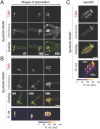The SpoIIQ-SpoIIIAH complex of Clostridium difficile controls forespore engulfment and late stages of gene expression and spore morphogenesis
- PMID: 26690930
- PMCID: PMC4982068
- DOI: 10.1111/mmi.13311
The SpoIIQ-SpoIIIAH complex of Clostridium difficile controls forespore engulfment and late stages of gene expression and spore morphogenesis
Abstract
Engulfment of the forespore by the mother cell is a universal feature of endosporulation. In Bacillus subtilis, the forespore protein SpoIIQ and the mother cell protein SpoIIIAH form a channel, essential for endosporulation, through which the developing spore is nurtured. The two proteins also form a backup system for engulfment. Unlike in B. subtilis, SpoIIQ of Clostridium difficile has intact LytM zinc-binding motifs. We show that spoIIQ or spoIIIAH deletion mutants of C. difficile result in anomalous engulfment, and that disruption of the SpoIIQ LytM domain via a single amino acid substitution (H120S) impairs engulfment differently. SpoIIQ and SpoIIQ(H120S) interact with SpoIIIAH throughout engulfment. SpoIIQ, but not SpoIIQ(H120S) , binds Zn(2+) , and metal absence alters the SpoIIQ-SpoIIIAH complex in vitro. Possibly, SpoIIQ(H120S) supports normal engulfment in some cells but not a second function of the complex, required following engulfment completion. We show that cells of the spoIIQ or spoIIIAH mutants that complete engulfment are impaired in post-engulfment, forespore and mother cell-specific gene expression, suggesting a channel-like function. Both engulfment and a channel-like function may be ancestral functions of SpoIIQ-SpoIIIAH while the requirement for engulfment was alleviated through the emergence of redundant mechanisms in B. subtilis and related organisms.
© 2015 The Authors. Molecular Microbiology published by John Wiley & Sons Ltd.
Figures








Similar articles
-
To Feed or to Stick? Genomic Analysis Offers Clues for the Role of a Molecular Machine in Endospore Formers.J Bacteriol. 2022 Sep 20;204(9):e0018722. doi: 10.1128/jb.00187-22. Epub 2022 Aug 1. J Bacteriol. 2022. PMID: 35913150 Free PMC article. Review.
-
Regulation of Clostridium difficile Spore Formation by the SpoIIQ and SpoIIIA Proteins.PLoS Genet. 2015 Oct 14;11(10):e1005562. doi: 10.1371/journal.pgen.1005562. eCollection 2015 Oct. PLoS Genet. 2015. PMID: 26465937 Free PMC article.
-
Structure of components of an intercellular channel complex in sporulating Bacillus subtilis.Proc Natl Acad Sci U S A. 2012 Apr 3;109(14):5441-5. doi: 10.1073/pnas.1120087109. Epub 2012 Mar 19. Proc Natl Acad Sci U S A. 2012. PMID: 22431604 Free PMC article.
-
Zipper-like interaction between proteins in adjacent daughter cells mediates protein localization.Genes Dev. 2004 Dec 1;18(23):2916-28. doi: 10.1101/gad.1252704. Genes Dev. 2004. PMID: 15574594 Free PMC article.
-
A mother cell-to-forespore channel: current understanding and future challenges.FEMS Microbiol Lett. 2014 Sep;358(2):129-36. doi: 10.1111/1574-6968.12554. Epub 2014 Aug 28. FEMS Microbiol Lett. 2014. PMID: 25105965 Review.
Cited by
-
To Feed or to Stick? Genomic Analysis Offers Clues for the Role of a Molecular Machine in Endospore Formers.J Bacteriol. 2022 Sep 20;204(9):e0018722. doi: 10.1128/jb.00187-22. Epub 2022 Aug 1. J Bacteriol. 2022. PMID: 35913150 Free PMC article. Review.
-
A Recombination Directionality Factor Controls the Cell Type-Specific Activation of σK and the Fidelity of Spore Development in Clostridium difficile.PLoS Genet. 2016 Sep 15;12(9):e1006312. doi: 10.1371/journal.pgen.1006312. eCollection 2016 Sep. PLoS Genet. 2016. PMID: 27631621 Free PMC article.
-
Sporulation in solventogenic and acetogenic clostridia.Appl Microbiol Biotechnol. 2021 May;105(9):3533-3557. doi: 10.1007/s00253-021-11289-9. Epub 2021 Apr 26. Appl Microbiol Biotechnol. 2021. PMID: 33900426 Free PMC article. Review.
-
A sporulation signature protease is required for assembly of the spore surface layers, germination and host colonization in Clostridioides difficile.PLoS Pathog. 2023 Nov 13;19(11):e1011741. doi: 10.1371/journal.ppat.1011741. eCollection 2023 Nov. PLoS Pathog. 2023. PMID: 37956166 Free PMC article.
-
Genomic Study of a Clostridium difficile Multidrug Resistant Outbreak-Related Clone Reveals Novel Determinants of Resistance.Front Microbiol. 2018 Dec 6;9:2994. doi: 10.3389/fmicb.2018.02994. eCollection 2018. Front Microbiol. 2018. PMID: 30574133 Free PMC article.
References
Publication types
MeSH terms
Substances
Grants and funding
LinkOut - more resources
Full Text Sources
Other Literature Sources

